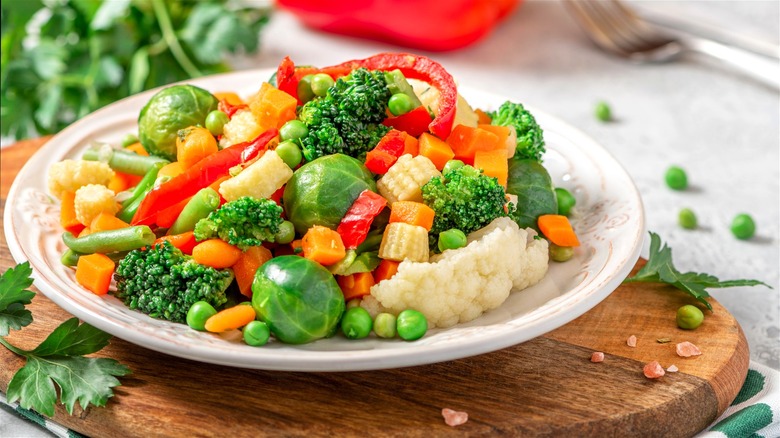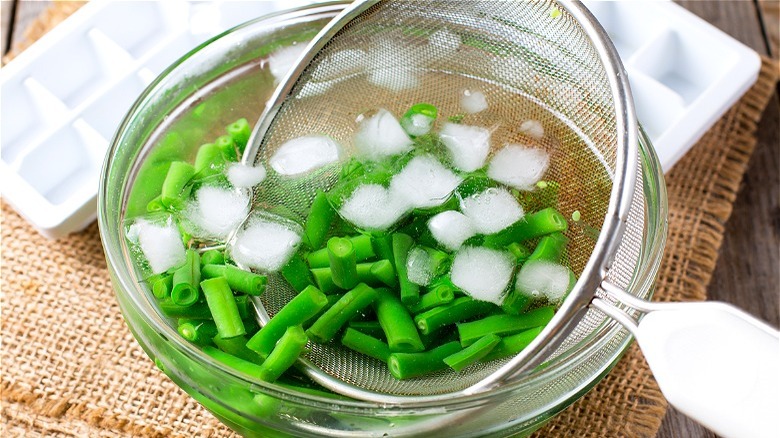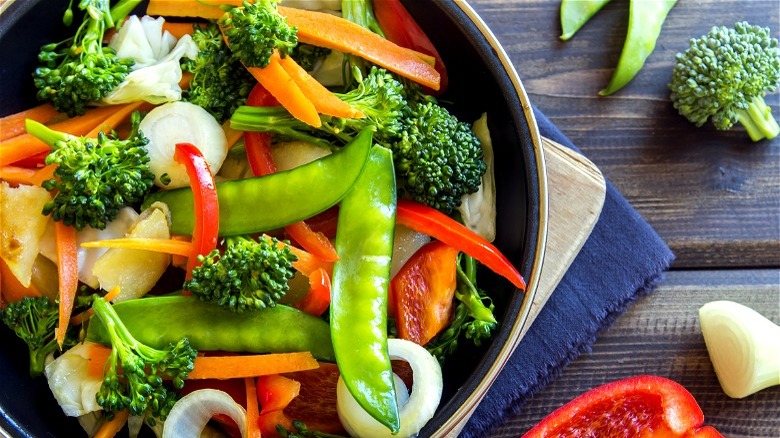Blanching Is The Surefire Way To Guarantee Vibrant Vegetables
We can all admit that eating healthy isn't always easy. Consuming the appropriate amount of vitamins and nutrients every single day can feel draining and time-consuming, especially when you're trying to find a creative way to cook drab-looking carrots at the end of a very long workday. However, one thing's for sure: vegetables go hand in hand with a well-rounded diet. According to findings from Food Insight's 2022 food and health survey, 60% of survey respondents care about the healthy attributes of their food purchases, and nearly 30% listed fruits and vegetables as the top contender for nutrient quality.
Even though adequate vegetable intake helps maintain a healthy mind and body, how many adults can safely say they meet the USDA MyPlate recommendation of two to four cups of vegetables per day? While many nutrient-rich plants fall under the umbrella of 50 foods that lower your risk of cancer, the truth is most adults don't eat enough. That being said, one 2021 survey conducted by Dr. Praeger's and OnePoll revealed that over 70% of participants wished they did, in fact, eat more vegetables, via Swns Digital. Yet, if you're not a fan of raw carrots or peppers, is there a way you can enjoy vegetables without cooking them into oblivion?
How blanching differs from steaming and boiling
There are many different ways to cook vegetables, but oftentimes you want to enjoy a fixed veggie without completely losing that crunchy texture. To blanch, steam or boil includes cooking vegetables with a pot of boiling water, but blanching involves a shorter cook time and a special step at the end of the cooking process. If you're on the fence about blanching versus steaming, being aware of their intrinsic differences is key. Steaming usually involves a steamer basket and cooks vegetables without direct contact with boiling water. Boiling involves placing vegetables directly in the hot water, as does blanching, but cooks vegetables to a higher degree of doneness.
Blanching or par-boiling involves cooking vegetables briefly in boiling water and then immediately placing them in cold water. To blanch vegetables, simply bring a pot of salted water to a boil and add in your vegetables of choice. Cook time ranges from five minutes for sliced carrots to only two minutes for various leafy greens. Now for the crucial step relegated to only blanched vegetables. Once the suggested cook time is over, remove your partially cooked veggies and shock them in a bowl of ice water to stop the cooking process completely. This unique method allows you to enjoy partially cooked vegetables in a variety of ways including on a charcuterie board with your favorite dip. Besides tempering raw vegetables, there are a number of positives to the blanching technique.
Blanching not only restores the color of your vegetables but prevents long-term nutrient loss
If you always turn down raw veggies, blanching proves to be a happy medium: you can cook vegetables without destroying their vibrant color and hearty texture. According to MasterClass, blanching removes the gas barrier between a vegetable's outer skin and true color. If you overcook your vegetables, their pigment will often dilute but if you blanch them properly, the process freezes partially cooked veggies in a way that is almost restorative in terms of color.
Blanching vegetables before freezing is also a crucial step for successful long-term storage. Blanching prevents the enzymes within a vegetable's makeup to degrade in color and texture when frozen. Blanching locks in nutrients making frozen vegetables just as nutritious as their raw cousins. Even if you don't plan on freezing your par-boiled veggies, there are other benefits to blanching. The blanching method also removes excess dirt and softens the surface area of many vegetables which can make their taste less harsh and enjoyable. You can also blanch vegetables before using them in another recipe that requires a shorter overall cook time, like kebabs or stir-fry. Lastly, blanching is effective at loosening the skin of certain fruits like peaches to preserve them more effectively. While steaming and boiling are useful methods if you want your vegetable fork tender, blanching toes the line between soft and crunchy and always delivers in both taste and appearance.


